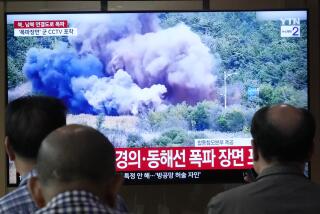2 trains cross Korean border
- Share via
MUNSAN, SOUTH KOREA — Carrying two official delegations and lofty hopes for Korean reconciliation, two trains pulled out of stations today in North and South Korea and crossed the demilitarized zone on a rail link severed by war almost 60 years ago.
The two trains -- one running north, the other south, along each coast -- covered a mere 16 miles each and were billed as a test run of tracks newly laid on the route of Korea’s colonial-era railroad.
But today’s short journeys had a larger symbolism, linking the two Koreas by tracks running through fields and over riverbeds once sown with landmines and between borders still bristling with weapons.
Many Koreans hope the inaugural run will lead to the eventual resumption of regular train service between the two countries, with the government in Seoul calling it an “impetus for peace.”
To the riffing of fireworks and a blast from the diesel engine’s air horn, the five-car passenger train scraped along the tracks out of Munsan Station, seven miles south of the border. On board were North Korean railway officials, South Korean politicians, peace activists and a poet.
They were sent off by a brassy military band and South Koreans waving blue-and-white unification flags. Riot police restrained a small group of protesters.
The train then made a brief stop at Dorasan Station, just before the DMZ, and then pulled away, spouting exhaust and blowing back white balloons and confetti.
“It’s my happiest day!” shouted the train’s driver.
The short-term ambitions for the line are more modest. South Korean officials argue that they need a train line to get raw materials and visitors to the 20 companies engaged in light industry at the Kaesong complex, a zone that brings together North Korean workers and South Korean capital and management. The trains could carry about 1,000 South Korean commuters a day to Kaesong, officials here say, as well as ease travel for North Korean workers who commute to the site by bus or bike.
The South also wants regular train service to boost tourism. About 6,000 South Koreans a month travel by bus to the Mt. Kumgang resort just across the border.
The government in Pyongyang has exploited Seoul’s eagerness to get the train line up and running. South Korea has already picked up the entire $600-million cost of building the line, providing all the construction materials and refurbishing the dilapidated stations along the route. Work began in 2002, with soldiers from both sides sweeping the area of landmines before laying the tracks.
But many observers here wonder what private deals Seoul may have offered to get the North’s agreement to start the trains.
The western line was completed more than five years ago. But the North Koreans had balked at starting the service, citing security concerns as well as unhappiness with the demarcation line between the two Koreas in the Yellow Sea that has led to a couple of bloody clashes in recent years. A similar test run scheduled for last year was abandoned on the day the trains were supposed to run, reportedly because of North Korean unhappiness with Seoul’s refusal to renegotiate the sea border.
For their part, South Korean officials argue that the North stands to reap even greater long-term economic benefits from re-welding a rail network that once stretched from the southern tip of this peninsula to the Chinese border. They hold out the prospect of tying both Korean economies into a greater Northeast Asian economic zone, one in which Korean goods can be shipped overland to China, Russia and Europe.
That enthusiasm has led the South Koreans to press ahead with this high-profile step toward reconciliation, despite the North’s lack of movement on a Feb. 13 deal to begin dismantling its nuclear weapons program.
The South Korean government’s insistence on carrying out the train test drew a rebuke from the Bush administration, which wants to see movement on the nuclear issue before Pyongyang reaps any economic rewards.
U.S. Ambassador Alexander Vershbow met Wednesday with South Korean Unification Minister Lee Jae-joung and later told reporters that “it is essential that the U.S. and South Korea work together to coordinate our efforts to the maximum degree possible.”
But the South Korean government says it will take any step that will build North Korean confidence and encourage engagement with its neighbor.
“We believe that inter-Korean development provides momentum and thrust for North Korea to implement their obligations,” Lee told a small gathering of Western news organizations Wednesday. “The test run of the train contributes to resolving the situation we’re in right now.”
*
More to Read
Sign up for Essential California
The most important California stories and recommendations in your inbox every morning.
You may occasionally receive promotional content from the Los Angeles Times.













